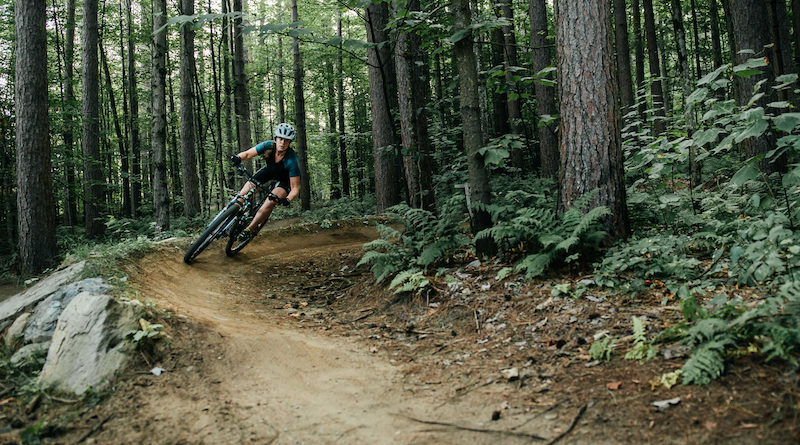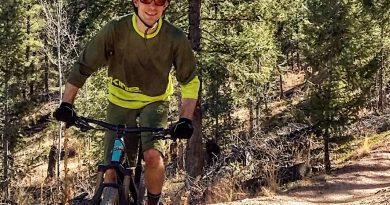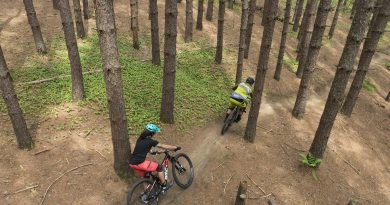The “Business” of Outdoor Recreation
Before we can grow our “outdoor economy” we need to focus on what’s already made Vermont a great outdoor recreation state: our trails and the organizations that maintain them.
BY TOM STUESSY
Outdoor recreation is part of who we are as Vermonters. When we get home after a ride, we are more accepting and peaceful because we’ve burned some of life’s challenges away. That difference is felt by everyone we interact with—at least until we get itchy to get back out.
When work gets stressful and my responses a bit shorter, my partner will ask me, “When was the last time you were on your mountain bike?” She understands that time on my bike is how I keep my life in balance. Most Vermonters can relate to the medicinal value of time in the woods and on trails.
While outdoor recreation is invaluable to us as individuals, the work it takes to build the trails does have a price tag.
The trail day volunteers of the Vermont Mountain Bike Association logged over 30,000 hours of volunteer time in 2018. This figure is dwarfed by the sum total of other trail-based nonprofits in Vermont. The economic value of trail volunteerism (at minimum wage) represents well over a million dollars every year, here.
To ensure continued and protected access to trails, trail-based nonprofits certainly need your trail day participation and membership dues. But if we want to continue the immense progress Vermont has made toward becoming a mountain biking, hiking and backcountry skiing destination—one that keeps Vermonters healthy and attracts new people to the state—trail-based nonprofits need more.
Businesses and government need to come together and recognize that without outdoor recreation there is no outdoor recreation economy.
Nationally, the “outdoor recreation economy” craze has quickly sparked a range of business-oriented reactions. Throw a rock and it’s likely you’ll hit another boutique gear endeavor. The rate at which fancy gear catalogs are showing up at the house has steadily ramped up. Universities are launching new Masters programs centered on the economics of outdoor recreation. For example, Western State Colorado University has launched a Masters in The Outdoor Industry. It will be interesting to see how this program, and others that are sure to follow, will incorporate the role of trail-based nonprofits as part of a sustainable business model.
Colorado, Maine, Oregon and many other states are creating state-funded offices of outdoor recreation focused on supporting the “industry.” The buzz is real and nonprofits in every state need to step up and take their place in this conversation.
Make no mistake, tourism is a 12-month national competition. To be competitive, Vermont would be well-served to fully invest in showcasing how and why we are unique. And our network of trail-based nonprofits is where it all starts—a network that isn’t replicated anywhere else in the country.
We also need outdoor-minded businesses of all types—not just those making socks or snowboards—to recognize what Vermont’s trail infrastructure means to their success.
Take country stores: They are iconic in Vermont. They’re also magnets for outdoor enthusiasts. A new trail network near a country store is a sure-fire way to increase revenue. Forty extra sandwiches a week is an important difference—that is the Vermont outdoor recreation economy.
Vermont’s outdoor ethos is illustrated through individuals’ connection to place. It’s also seen in our choices to go out of our way to support those businesses that reinforce those vibes, from a local bike shop or cheese coop, to insurance agencies, chiropractors and the local country stores.
In essence, Vermont’s outdoor recreation economy is a volunteer economy. A business doesn’t have to build or sell bikes to effectively show support. So, how do businesses of all types learn to embrace and take full advantage of partnering with nonprofits?
1. Share the connection between the trails and their value to your employees and customers.
2. Encourage your professional network of businesses and their employees to participate in membership, fundraising, events, trail days, etc. Co-host an appreciation party at your business.
3. Work with local trail-based nonprofits to engage their membership with things such as offering discounts to members for a newsletter announcement showing how your business supports community values. This will create a lot of excitement among your employees.
4. Offer in-kind expertise (say, legal advice or accounting) to local nonprofits to help an organization through growing pains. Your generosity will be reciprocated!
5. Host a unique event and bring other outdoor-minded businesses’ employees together. Illustrate that by measurably partnering with a local trail group each business can showcase how it values the community. Make the connection visible beyond a social post or newsletter.
6. Extend nonprofit membership as part of your employee benefits program.
7. Name a trail grant on behalf of your employees. See if your employees are willing to set up the grant criteria and comprise the selection team. Follow up by hosting a trail day with your employees to help build the project in concert with the local trail group.
8. Partner with a local outdoor store or organization to demo some equipment for your employees – link the event to the local trail organization.
There are a few outdoor businesses in Vermont that do an amazing job of this. Outdoor Gear Exchange supports a long list of community outdoor grants every year. Skirack has been a longtime supporter of the Vermont Mountain Bike Association through grants and is a trusted sounding board for new ideas. Cabot Co-op was the first to support the “Naming Trail Grant” concept, where a business establishes grant criteria, serves on the award committee and encourages their staff to participate in trail days for their project. This couples businesses of all types with VMBA in a manner that allows them to share an excitement for what is important to their employees and community. FUSE Marketing, VESCU, Good Luck Coffee, Long Trail Brewery, Repro, Kaden Apparel, SDR Clothing, rkMiles and others have illustrated to their employees, customers and community that trails require investment.
Moving forward, trail-based nonprofits and their members need to point out their value and role in the “outdoor recreation economy” at every opportunity. If we all were to be in touch with our legislative representatives and expressed how they can support our trail organizations, our collective power would be magnificent.
When speaking with your representative, encourage them to advocate for all public land managers to embrace long-range planning for trail building, and utilize the lead of trail-based nonprofits to get more outdoor-minded business involved.
This will serve multiple important outcomes. For example, it will help ensure ecological sensitivity and support a range of recreational pursuits, leading to more tourism and its tremendous economic benefits. It will keep Vermont’s amazing volunteer force excited. It will help to disperse user demand, which is quickly intensifying and putting more pressure on volunteerism. Lastly, it will help to align fundraising with clear timelines and state and federal grant cycles. Creating this clarity is a critical part of keeping communities involved.
Nationally, this discussion can evolve to meaningfully illustrate the fragile balance between outdoor recreation and outdoor-minded business, and highlight which inspires the other.
For more information on how Vermont’s outdoor-minded businesses are doing a great job of aligning with outdoor recreation, see vmba.org/voice/.
Tom Stuessy is executive director of the Vermont Mountain Biking Association.
Featured Photo Caption: VMBA volunteers logged over 30,000 hours last year to build trails like this one. Photo courtesy VMBA




